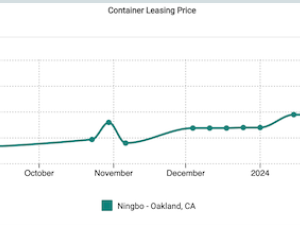Carriers remain optimistic about 2017 despite capacity warnings from analysts
posted by AJOT | Apr 25 2017 at 11:09 AM | Liner Shipping
Despite growing confidence in a container market recovery over the past six months, a leading shipping analyst has predicted the return of freight rate volatility to the world’s major trades as the spectre of overcapacity comes back to haunt the industry.
Tan Hua-Joo, executive consultant at Alphaliner, told delegates at the TOC Asia Container Supply Chain event that launched in Singapore this morning that despite 2016 being the “most balanced year in terms of supply and demand since 2009”, with a global fleet growth of just 1.6%, that “hopes on the part of carriers for greater stability are still some time away”.
This is largely because the growth rate last year was constrained due to a high number of new vessel delivery deferrals, in combination with an unprecedented number of vessels sent to scrapyards and an unnaturally large idle fleet propelled by the collapse of Hanjin.
“As we move into this year the rate of growth in the global fleet is going to increase as there is very little room for the industry to keep the growth of fleet down,” he said.
However, this view was contradicted by Robbert van Trooijen, head of Maersk Line for Asia-Pacific, who claimed that 2017 would be the year “in which all of us would find that balance”.
Alphaliner is forecasting total fleet delivery of 1.32m teu, most of which will be new ultra-large container vessels (ULCVs), and although it is also forecasting another year of record scrapping levels – up to 700,000 teu – there will still be a net increase in the global fleet of 620,000 teu, which would represent a 3.1% increase.
Altogether, 1.6m teu of the world’s fleet found itself idled last year, although some 500,000 teu of this was Hanjin tonnage, and much has been brought back into operation.
“A lot of the Hanjin vessels have been brought back into operation and Panamax vessels have seen something of a spike in demand due to the new alliances’ demand for capacity, leading to charter rates going back up to around $10,000 per day.
“The idled Hanjin tonnage is now down to about 200,000 teu, and we expect this be reintroduced to by May.
“So as long as the shipping lines take back this idle capacity there is no sign of a recovery in the market as carriers continue to bid for market share and significant freight rate stability will continue.
“In fact, we do not see a genuine recovery in the freight markets for another 18 months – it is not until 2019 that the supply-demand situation comes back into balance,” he said.
However, Mr van Trooijen argued that on the transpacific, Asia-US east coast and Asia-North Europe trades capacity was likely to be far more in line with demand than Mr Tan suggested.
“It depends when the comparison is made. On Asia-US east coast, there was 148,000 teu deployed at the height of capacity last year, and although it has been growing since Hanjin’s bankruptcy it is now at 144,000 teu per week.
“The transpacific trade is showing a similar pattern and if you compare the capacity on Asia-North Europe in January 2016 with the anticipated deployment in December this year – even with the newbuildings coming in – it is 240,000 teu per week compared to 237,700 teu.
“In view of all this, I think we should be confident that the capacity injected in the east-west trades is more balanced than it was,” Mr van Trooijen concluded.





